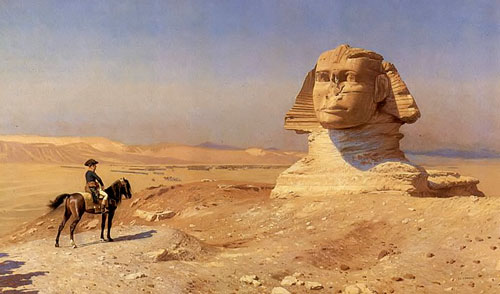
GEOGRAPHY
Without the Nile River, all of Egypt would be desert. Only about an inch (2.5 centimeters) of rain falls throughout Egypt each year. But each summer, the river rises because of rains at its source far to the south in Ethiopia. Floods cover the river's valleys, leaving sediments needed for trees, plants, and crops to grow.
Egypt is often divided into two sections: Upper Egypt in the south and Lower Egypt in the north. The sections are named this way because the Nile flows from south to north. The river empties into the Mediterranean Sea.
Southern Egypt's landscape contains low mountains and desert. Northern Egypt has wide valleys near the Nile and desert to the east and west. North of Cairo, the capital, is the sprawling, triangular Nile River Delta. This fertile land is completely covered with farms.
NATURE
Egypt is home to a wide variety of animals and plants, including cheetahs, hyenas, crocodiles, and cobras. The best places to see Egypt's wildlife are in its 21 protected regions, which include oases, deserts, mountains, coastal areas, river islands, and wetlands.
Egyptians have always been close to the natural world. The ancient Egyptians left paintings and carvings of large animals like elephants, hippos, leopards, and cheetahs. These animals were once common in Egypt, but they are now rare or extinct because of hunting and habitat loss.
PEOPLE & CULTURE
About 90 percent of Egyptians are Muslim, which means they are followers of the Islam religion. Islam dominates Egyptian society. About 10 percent of Egyptians are Copts, one of the oldest branches of the Christian religion.
Egypt's population is growing rapidly. This puts strains on Egypt's resources, since most people live in a narrow strip of land along the Nile River. Having so many people in such a small area causes overcrowding everywhere, from schools to apartment buildings to hospitals.
Children are highly valued in Egypt, especially in rural areas where they help on family farms. Children are also expected to look after their parents in their old age.
HISTORY
The first people to live on the banks of the Nile were hunters and fishermen, who settled there over 8,000 years ago. They learned to grow crops and raise animals, and they began to build villages and towns. They traded with their neighbors and learned to sail boats. By 3000 B.C., a civilization was established.
Around 3100 B.C., the kingdoms of Upper and Lower Egypt were unified under a powerful king, later called a pharaoh. These kings built huge pyramids, temples, and other monuments. They also conquered other lands.
By 1000 B.C., Egypt had split into smaller parts and the kingdom was in decline. Strong neighbors attacked and took over Egyptian territory. In 31 B.C., Egypt fell under Roman control. In A.D. 640, Muslim warriors took over Egypt and founded the modern capital, Cairo. They ruled for several centuries.
In 1882, the British invaded and occupied Egypt. The British wanted control of the Suez Canal, which linked the Mediterranean Sea with the Red Sea and greatly shortened the sailing trip from Asia to Europe. The British stayed until Egypt declared independence in 1952.
GOVERNMENT & ECONOMY
Egypt's geography, population, history, and military strength have made it highly influential in the region. Egypt is a democratic republic, although some critics claim that it is not truly democratic. Until 2005, there was never more than one presidential candidate to vote for.
Despite its oil and gas exports, Egypt's largest single source of foreign income is tourism. Visitors flock to the country to see ancient monuments like the Great Pyramids and the Sphinx.


